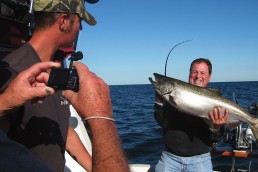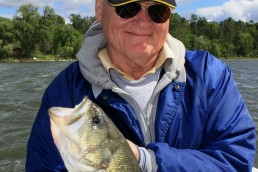Avoid Crummy Fishing Photos
SHARE THIS POST
There’s nothing better than a good fishing photo. Sadly, most photos are crummy. The common complaint used to be, “Oh rats! I forgot to bring the camera.” Almost as common a complaint was, “I’m out of film.”
At least with fewer fishing photos there were fewer bad ones.
That has changed in our modern, cyber-society. And who doesn’t have a smartphone capable of snapping a photo? And how many photos will fit on one of those devices, anyway? Who will see them? Potentially, everyone thanks to social media. But in the long run one thing remains consistent: most of the fish pictures are again, still crummy. Catch a fish, grip it, hold it toward the camera so it looks bigger than it is, smile and click—you’ve now become the subject of a fish picture. At best, you’ll be able to identify the fish, and perhaps the fisherman.
It’s a mug shot; it’s like a crime-scene photo: “See here judge, the photo proves the accused fisherman caught the alleged fish.”
This isn’t a good fish photo.
By now you see the problem, but there are some solutions and tips. I’m not a professional photographer, but I have taken a few really neat fish photos.
Tip 1: A smartphone can take a really nice photo.
These phones are multitaskers, but don’t always perform as efficiently, reliably or as well as a regular camera. Smartphones are every bit as capable as a digital camera and have high pixel resolutions, but when someone is holding a flopping fish in front of me it’s hard to quickly remember what sequence of spots to touch on the phone’s screen to change my camera settings. I just touch the “click” spot and hope for the best. If possible, use a regular digital camera.
Are you enjoying this post?
You can be among the first to get the latest info on where to go, what to use and how to use it!
Tip 2: Since film and processing costs are non-existent and cameras and smartphones can take uncountable numbers of photos, take many photos, not just one.
Tip 3: Delete 90 to 99 percent of the photos snapped (see Tip #2).
Tip 4: Sometimes natural lighting is perfect.
A quality pic can be obtained using only the light from the sun. Professional photographers rarely rely on natural lighting, but the least you can do is learn to make your digital camera or smartphone flash for every photo. Take some pictures with and without the flash on.
Tip 5: Learn the zoom features on cameras and crop features on a smartphone.
Most cameras have optical (mechanical) zooms where the lens actually moves in or out. Use it to pull the subject matter in closer. Phones have purely digital zooms. As long as you know how to crop a smartphone pic there’s no need to worry about an increase in picture quality that’s garnered by zooming in or out. Almost every photo I submit for MidWest Outdoors magazine, post on Facebook or save for posterity is cropped to some extent.
Tip 6: Good fish photos show action.
Live action is great; posed action is easier. For a challenge, show the fish being landed or netted, lifted from a net, being unhooked, being kissed or released, being put into the cooler, etc. Each tells a story and can be a great picture you’ll love to see over and over and want to be proud to post.
MWO
SHARE THIS POST
Did you enjoy this post?
You can be among the first to get the latest info on where to go, what to use and how to use it!
Mike Schoonveld
A passion for hunting, fishing, trapping and an outdoor lifestyle has been true north on Mike Schoonveld’s compass his whole life. One of the Midwest’s most prolific outdoor communicators, scores of his columns have been published in the pages of MidWest Outdoors since the first one appeared in 1987.



